Random Disk Usage Spikes on Windows 11? Here’s How to Fix It
With all the good things that arrived with Windows 11, there is also a slew of old issues that we’re migrated over from older Windows versions. Perhaps one of the most popular examples is the disk usage spike issue. Even in idle mode, some Windows 11 users are reporting that they notice their HDD sitting at 100% usage when checking Task Manager.
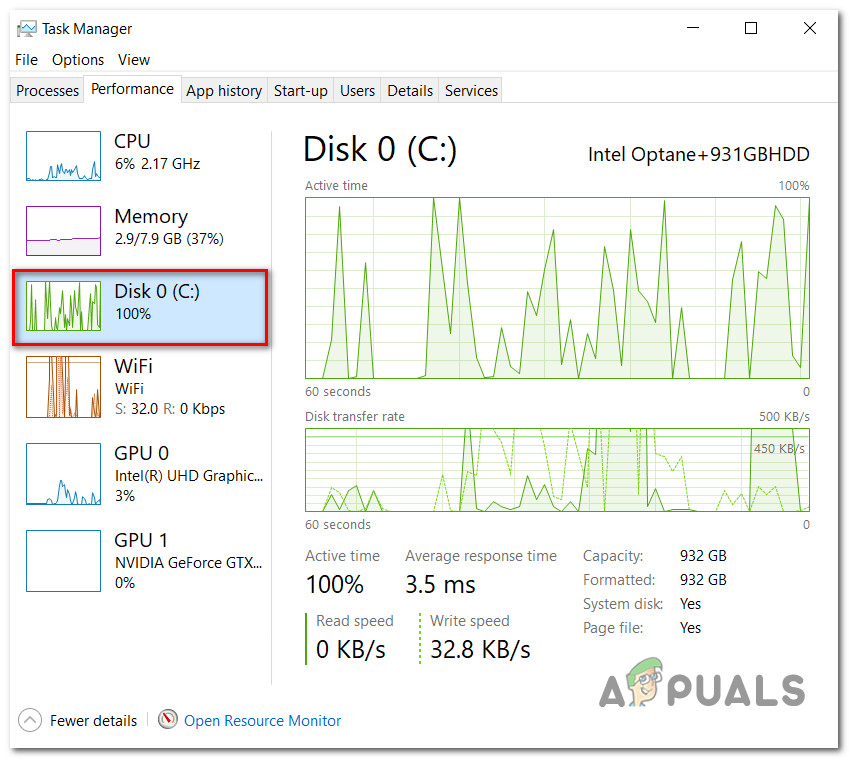
After investigating this particular issue thoroughly, it turns out that there are several different underlying causes that are most likely triggering this problem on Windows 11. Here’s a shortlist of potential culprits that you should be aware of:
- Drive fragmentation – If you’re using a traditional HDD drive and you purposefully turned out the auto-drive optimizing function, chances are you will get these usage spikes as your drive gets more and more disorganized. To fix this particular issue, you’ll need to defragment the drive that is currently holding your Windows 11 installation.
- Application Management service glitch – If you’re looking for a temporary fix that will most likely bring the usage of your drive down from 100%, you should restart the Application Management service from the Services screen. This will temporarily fix a notorious glitch that Microsoft is working on fixing since the Windows 10 era.
- CompatTellRunner.exe is hogging the storage capacity – As it turns out, the CompatTelRunner.exe process is a likely culprit if you’ve installed Windows 11 on a unit with limited computing power (barely meeting the minimum CPU requirement). In this case, you should be able to fix the issue by disabling the usage of the CompatTelRunner.exe process either via Task Scheduler or via Registry Editor.
- Failing HDD drive – It’s not uncommon to face this particular issue if you’re starting to deal with a traditional HDD that is beginning to degrade before eventually failing. If you notice 100% disk usage during idle periods, you should deploy a SMART scan via Speccy (or a similar tool) that is capable of showing a detailed view of your drive’s health parameters.
- Windows Security glitch – As it turns out, certain insider builds of Windows 11 are dealing with a weird glitch where Windows Security eventually takes up 100% of the disk usage as it’s trying to download a new virus definition. To fix this particular issue, you’ll need to disable both Windows Defender and Windows Firewall and trigger a restart before re-enabling them back.
- 3rd party process/startup item interference – Another potential reasoning on why you’re constantly dealing with this type of issue is some kind of 3rd party interference that is hogging the available system resource. You can identify the culprit and deal with it (in most cases) by achieving a clean boot state.
- High Disk Usage caused by the Indexing service – If you’re experiencing this issue only during idle periods and you have low-end specs, another potential culprit that you should troubleshoot against is the Indexing service. If this scenario is applicable, you should be able to fix the problem by pausing the Indexing Options service.
- Windows search glitch – Certain Windows 11 insider builds are suffering from this issue where the disk effectively gets overwhelmed whenever you try to use the Windows Search component (or your OS does it in the background). To avoid this problem, you can either update to the latest Windows 11 build or you can effectively stop the Windows Search service via Task manager.
- An issue with the Link Power Management feature – This power management feature is still unreliable on Windows 11, particularly with laptops and ultrabooks where Intel’s Rapid Storage technology is installed. To fix this problem, you’ll need to disable this feature from the Power Options menu.
Now that we went over every potential reason why you might experiencing disk usage spikes to 100% on Windows 11, let’s get to the fixing part.
Here’s a collection of methods that other users suffering from the same kind of issue have successfully used to resolve this problem completely:
1. Defragment Operating System drive
If you’re still using a traditional HDD and you previously turned off the Defragment and driver optimizing function, chances are you’re seeing this type of issue because the file system on your OS partition is getting disorganized as more files are added to the mix.
Several affected users that we’re also dealing with this problem have confirmed that they managed to fix the problem by running the Optimize Drives utility.
Note: You can also run the optimization function on SSD drives too, but they’re generally more resilient to slowdowns caused by file fragmentation.
Follow the instructions below to optimize the drive that is causing disk usage spikes on Windows 11:
Note: While you’re optimizing the OS drive, you should also consider enabling the Scheduled optimization feature to ensure that this type of problem won’t resurface in the future.
- Press Windows key + R to open up a Run dialog box. Next, type ‘dfrgui.exe’ inside the text box and press Enter to open up the Optimize drives utility.

Open up the Optimize Drives menu - Once you’re inside the Optimize Drives menu, select your HDD operating system drive, then click the Optimize button below.

Optimize the HDD drive - When you’re prompted by the User Account Control menu, click Yes to grant admin access.
- Once the setup gets going, wait until the operation is complete and stop yourself from force-stopping the operation before it’s complete – doing this runs the risk of creating additional fragmentation issues with your drives.
If this method was not applicable in your particular scenario, move down to the next potential fix below.
2. Restart the Application Management service
If you’re looking for a temporary fix that will allow you to use your PC normally without identifying the root cause of the problem, you should open the Services screen and simply restart the Application Management service.
This will resolve a glitch that is around since Windows 10 where the disk eventually gets overwhelmed as the Application Management service is unable to handle the stream of data it’s being assigned.
Restarting this service will most likely bring the disk usage down considerably, but the fix will only be short-lived. You should expect the problem to return the next time you boot up your Windows 11 computer.
Follow the instructions below to restart the Application Management service on Windows 11:
- Press Windows key + R to open up a Run dialog box. Next, type ‘service.msc’ and press Enter to open up the Services screen.

Open up the Services screen - Once you’re prompted by the User Account Control (UAC), click Yes to grant admin access.
- Inside the Services screen, scroll down through the list of services inside and locate the Application Management.
- Once you locate the correct service, right-click on it and choose Restart from the context menu that just appeared.
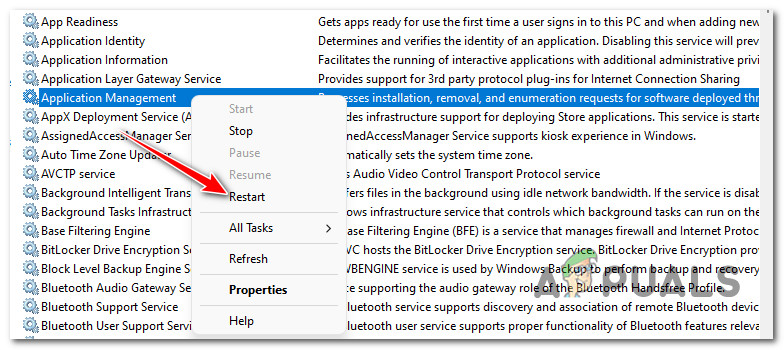
Restarting the Application Management menu - Once the Application Management service has been stopped check Task Manager once again and see if the problem is now fixed.
If the same kind of problem is still occurring, move down to the next potential fix below.
3. Disable the CompatTelRunner.exe process
Another possible reason why you might be experiencing this type of massive disk usage even in situations where your PC is not really doing anything is the CompatTelRunner.exe process.
This service uses the Telemetry component to collect system data that will be used by Microsoft’s team to improve the security and quality of service.
The thing is you don’t get any immediate benefit from allowing CompatTelRunner.exe process to run in the background. Even more, if your PC has limited computing power and you’re using a traditional drive, you can expect this component to do more bad than good since it might end up taking up all your disk reading speed as it’s sending Telemetry data to Microsoft’s servers.
If this scenario is applicable, you actually have two ways that will allow you to fix the issue:
- Disable the CompatTelRunner.exe process via Task Scheduler
- Disable the CompatTelRunner.exe process via Registry Editor
We’ve covered both of these methods, so feel free to follow the sub-guide that you feel most comfortable with.
Note: Both of these methods are tested and confirmed to be working on Windows 11.
Disable the CompatTelRunner.exe process via Task Scheduler
If you decide to disable this component via Task Scheduler, you’ll actually need to disable all three tasks associated with the main CompatTelRunner.exe. You can locate all three of these tasks under Application Experience.
Follow the instructions below for specific instructions on how to do this:
- Press Windows key + R to open up a Run dialog box. Next, type ‘taskschd.msc’ inside the text box, then press Enter to open up the Task Scheduler.
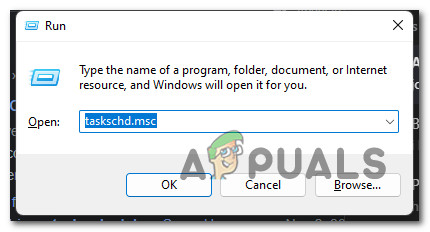
Open up the Task Scheduler - If you’re prompted by the User Account Control, click Yes to grant admin access.
- Once you’re inside the Task Scheduler utility, navigate to the following location using the menu on the left:
Task Scheduler Library > Microsoft > Windows > Application Experience
- Once you’re finally inside the correct location, move over to the right-hand section of the screen and systematically disable all three tasks inside by right-clicking each and choosing Disable from the context menu.

Disabling every task linked to CompatTellRUnner - Once every involved task is successfully disabled, reboot your PC and see if the disk usage problem is fixed once the next startup is complete.
Disable the CompatTelRunner.exe process via Registry Editor
If you want to avoid Task Scheduler for some reason, you can also stop the CompatTellRunner.exe process from producing effects on your Windows installation by renaming a Registry key used by the telemetry data collection component.
To do this, follow the instructions below to use Registry Editor to rename the TelemetryController key so that you force your OS to disregard it.
Follow the instructions below:
- Press Windows key + R to open up a Run dialog box. Next, type ‘regedit’ inside the text box and press Ctrl + Shift + Enter to open up the Registry Editor with admin access.

Open up the Registry Editor - When you’re prompted by the User Account Control window, click Yes to grant admin access.
- Once you’re inside the Registry Editor, use the side menu on the left to navigate to the following location:
HKEY_LOCAL_MACHINE\SOFTWARE\Microsoft\Windows NT\CurrentVersion\AppCompatFlags\TelemetryController
Note: You can either navigate to this location manually (by clicking on each key) or you can paste the full path directly into the navigation bar at the top to arrive there instantly.
- Once you arrive at the correct location, simply right-click on TelemetryController and choose Rename from the context menu.

Rename the TememetryController key - Next, rename TelemetryController to TelemetryControllerX in order to for your operating system to disregard these keys completely.
- Once this modification has been operated, reboot your PC and see if the problem is fixed once the next startup is complete.
If the same kind of problem is still occurring even after you disabled the effects of CompatTelRunner.exe, move down to the next method below.
4. Test for a failing Drive
If the methods above haven’t brought you closer to solving this issue, you should also start contemplating a potential failing drive (especially if you’re using a traditional HDD).
The reason why your disk has periods when it stays at 100% usage during idle periods on Windows 11 might be because it’s beginning to fail.
If you’re dealing with this type of scenario, there’s one free 3rd party tool called Speccy that will allow you to investigate if your HDD / SSD is indeed failing or not.
Note: If this method concludes that your drive is not failing, you can conclude that the cause is software-related.
Speccy will give you an overview of about 30 SMART points that measure the health of your drive. If all the measurements are within the normal range, your drive is not failing.
Follow the instructions below to install and use Peccy to figure out if you’re experiencing 100% disk usage due to a failing drive:
- First things first, open your favorite browser and visit the download page of Speccy.
- Once you’re inside, click on the Download button associated with the free version of Speccy.

Downloading the free version of Speccy Note: As of now, you don’t need the paid (Professional) version in order to check out the SMART parameters, so don’t buy it unless you have a use for it.
- Once the download is complete, double-click on spsetup.exe, then click Yes at the User Account Control (UAC) prompt to grant the required admin access.
- Once you’re inside the installation prompt, follow the on-screen instructions to complete the installation of Speeccy, then reboot your PC when prompted to do so.
- After your PC boots back up, run Speccy and wait until the initial scan is complete, then click on Storage from the menu on the left.
- With the Storage menu selected. move over to the right-hand section and scroll down to the Smart Attributes section.

Checking the health of HDD / SSD Note: Check the status of every attribute name and see if any of the values are deviating from the expected values. If you find multiple attributes that are not labeled as Good and are exceeding the threshold, you can conclude that you’re dealing with a drive that is beginning to fail.
In case this investigation has shown you that you’re indeed dealing with a failing drive, the only viable at this point is to look for a replacement and back up your existing data while you’re still able to boot normally.
On the other hand, if you’ve just concluded that the problem is not related to a failing drive, move down to the next potential fix below.
5. Restarting Windows Security (if applicable)
If you’re using the default security protection method on Windows 11 (Windows security), the 100% disk usage that you’re seeing inside Task Manager can also be caused by the ‘definition download’ glitch that ends up keeping the load at 100% even after the download of the new virus definition is finished.
This problem was originally reported on Windows 10 and it’s now migrated to Windows 11 too.
Until Microsoft finally gets around to resolving this problem, the only viable fix that other affected users have discovered is to temporarily restart your system with the security suite disabled – upon doing this and re-enabling the built-in Windows Security suite, a lot of users have confirmed that the disk percentage has finally returned to normal.
If this scenario is applicable and you’re looking for specific instructions on how to do this, follow the instructions below:
- Press Windows key + R to open up a Run dialog box. Next, type ‘ms-settings:windowsdefender’ inside the text box, then press Enter to open up the WIndows Security tab of the Settings menu on Windows 11.
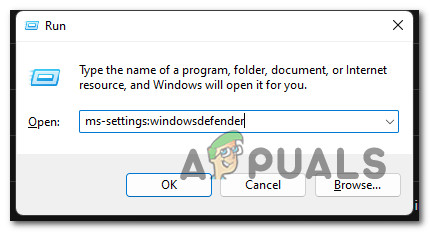
Opening up the Windows Defender menu - If you’re prompted by the User Account Control, click Yes to grant admin access.
- Once you’re inside the correct menu, move over to the right-hand pane and click on Open Window Security.

Open Windows Security - Once you’re inside the main menu of Windows Security, click on Virus & threat protection from the list of available options.
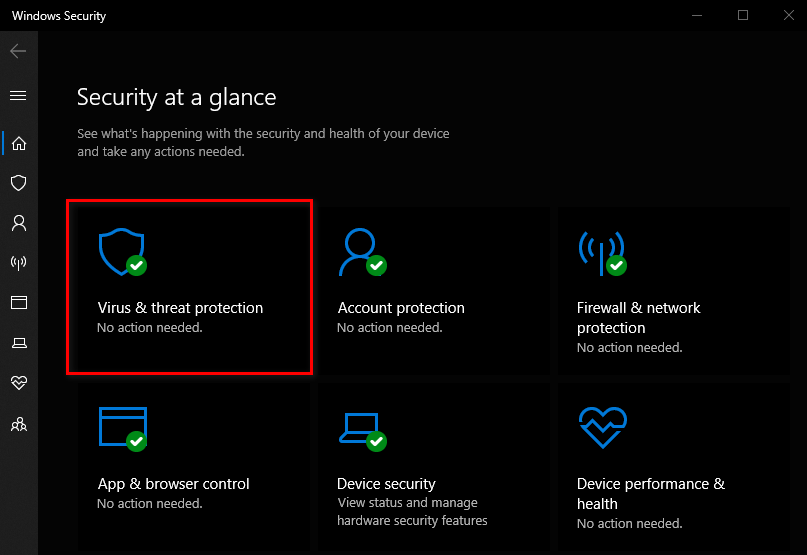
Accessing the virus and threat protection tab - Once you’re inside the dedicated Virus & threat protection menu, click on Manage settings from the context menu that just appeared.
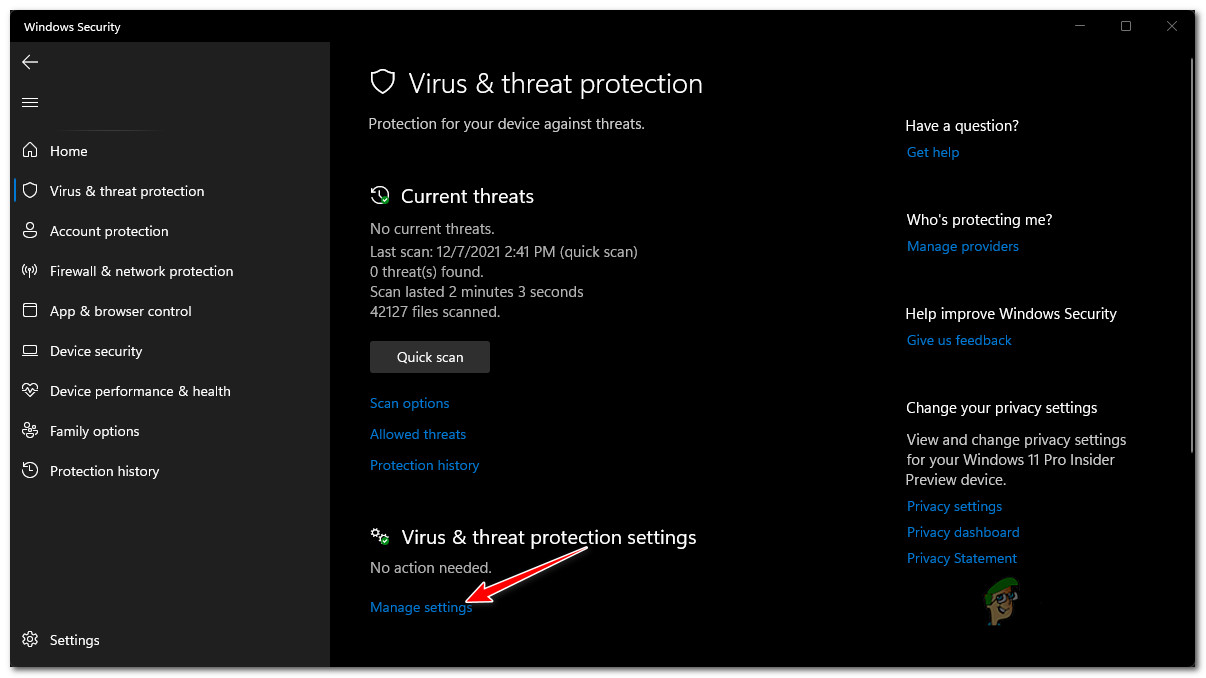
Managing the Settings menu - From the Virus & threat protection settings, scroll down and uncheck the box associated with Real-time protection.
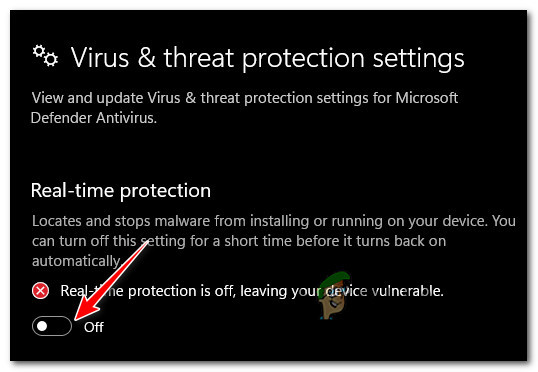
Disable the real-time protection on Windows Security - When you’re prompted by the User Account Control (UAC), click Yes to grant admin access.
- Next, hit the back button until you return to the Home screen of Windows Security, then click on Firewall & network protection.

Firewall and network protection - Next, click on whichever network is currently active (Domain, Private, or Public).
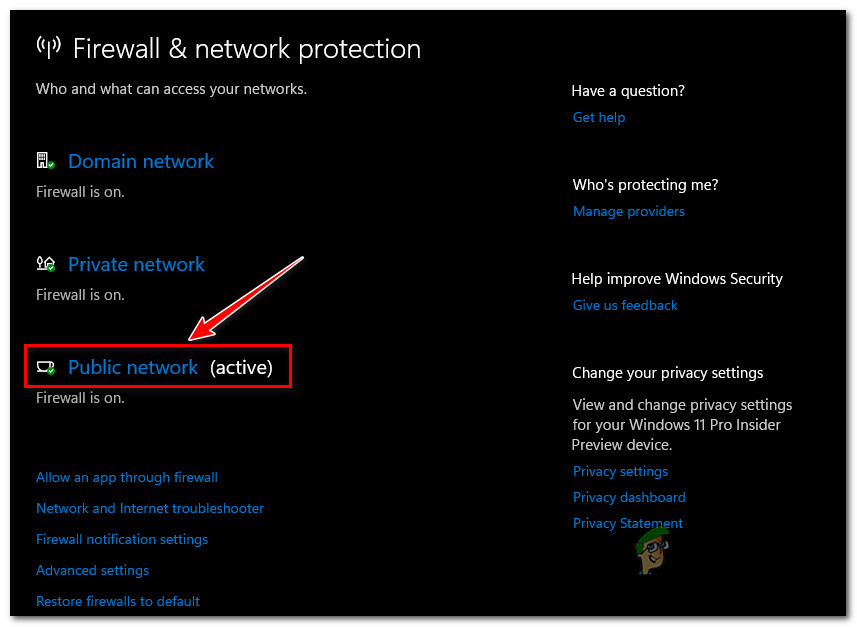
Accessing the Public network menu - From the next menu, simply switch the toggle associated with Microsoft Defender Firewall to Off.
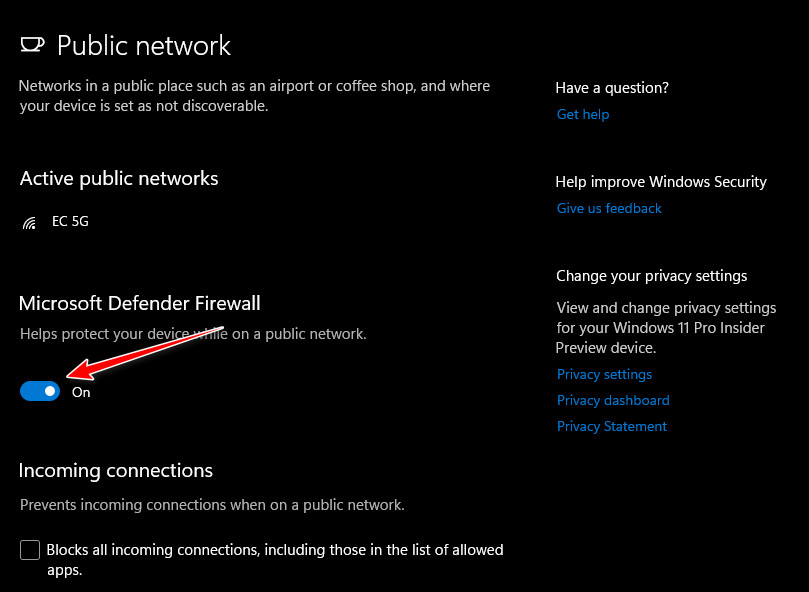
Disable the Windows Firewall - Reboot your PC once again and see if the problem is finally fixed.
- After your Windows 11 PC reboots, check the usage of your disk and see if the usage value has gone down. If it has, simply reverse the steps above to re-enable both the real-time protection and the firewall component on Windows Defender.
If the problem did not fix the disk usage issue in your case, move down to the next potential fix below.
6. Clean boot and isolate the issue
As it turns out, this particular issue can also be rooted in some kind of 3rd party interference caused by a startup item, or process belonging to a 3rd party application that ends up hogging way too many available system resources.
Since there are a lot of potential culprits that can be responsible for this type of issue, the best way to isolate and eliminate the problem is to perform a clean boot and systematically re-enable every disabled service until you manage to pinpoint the problem.
Note: This method is often reported to be effective in scenarios where the affected users have just migrated to Windows 11 from an older version. Most commonly, the problem occurs due to a native Windows 10 app that is not yet adapted to work for Windows 11.
Follow the instructions below for specific instructions on starting your Windows 11 PC in clean boot mode and identifying the program that’s hogging the available drive bandwidth:
Important: In order to be able to follow the instructions above, you’ll need to be signed into an account with admin access.
- Press Windows key + R to open up a Run dialog box. Next, type ‘msconfig’ inside the text box and press Enter to open up the System configuration menu.
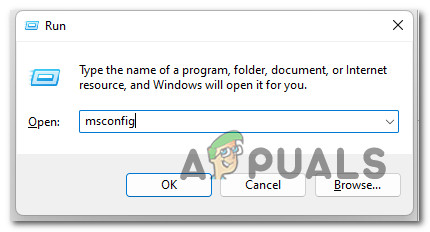
Open the Msconfig utility - When you’re prompted by the User Account Control (UAC), click Yes to grant admin access.
- Once you’re finally inside the System Configuration menu, select the Services tab from the list of available options, then check the box associated with Hiding all Microsoft services.
- Next, go ahead and take a look at the remaining services and hit the Disable all button to ensure that the next startup is performed without any non-essential 3rd party services.
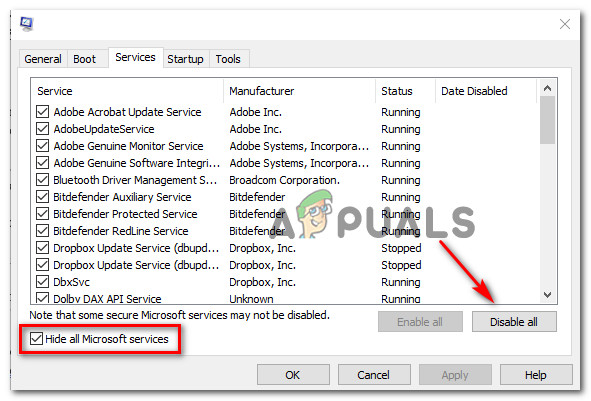
Disable each 3rd party service - After you do this, click on Apply to save the changes, then select the Startup tab and click on Open Task Manager.

Open up the Task Manager - Once you’re inside the Startup tab of Task Manager, go ahead and select each service individually, then click on the Disable button for each item. This will prevent these services from running during the next system startup.

Disabling all services from the next startup - Now that every potential conflicting item has been disabled, reboot your computer normally and see if the disk usage is now improved now that you have achieved a clean boot state.
- If the problem is no longer occurring, you should revisit steps 3 and 5 and begin to systematically re-enable the previously disabled startup items and services and reboot constantly to pinpoint exactly which item is causing the problem.
If achieving a clean boot state didn’t allow you to fix the issue, move down to the next potential fix below.
7. Pause the Indexing Options service
As it turns out, if you’re running Windows 11 on a low-end PC that barely meets the minimum specifications, this particular issue can also be caused by an indexing glitch.
According to other affected users, if the indexing feature is having trouble getting hold of the required resources to index all required files, it will effectively keep the disk usage at 100% (even during idle periods) as it tries to catch up.
If this scenario is applicable, one way of fixing the issue is to simply disable indexing on your PC.
Note: Doing this means that your files will stop getting indexed which will prevent you from finding them quickly when you search for something. However, it’s still better than being forced to get through the occasional moments where your operating system freezes for a few minutes.
Follow the instructions below to learn how to pause the indexing service via the classic Control Panel feature:
- Press Windows key + R to open up a Run dialog box. Next, type ‘control’ inside the text box, then press Enter to open up the classic Control Panel interface.

Open up Control Panel - Once you’re inside the classic Control Panel interface, use the search function (top-left corner) to search for ‘indexing’ then click on Indexing Options from the context menu that just appeared.

Opening the Indexing Options menu - Once you’re inside the Indexing Options menu, select each folder inside, click on Modify, then click the Pause button from the handle below.
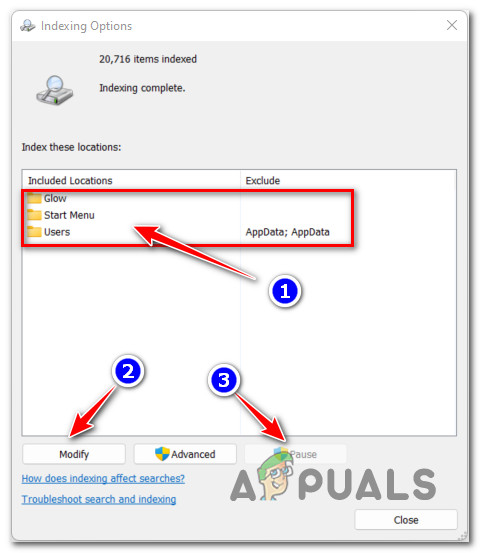
Pausing the indexing feature on Windows 11 - Once the indexing feature has been disabled, reboot your PC once again and see if the problem is fixed once the next startup is complete.
If you’re still dealing with the same kind of storage usage during idle periods, move down to the next potential fix below.
8. Stop the Windows Search service (temporary fix)
If you previously disabled the Windows Search service and this didn’t improve the disk usage spike issue you’re dealing with on Windows 11, the next thing you should investigate is the Windows Search functionality.
Other users that we’re also dealing with this particular type of issue have confirmed that the problem was resolved once they force-stopped the Windows Search service via the Services tab of Task Manager.
Note: Keep in mind that this is only a temporary fix. Expect the issue to return promptly after you restart your PC.
Follow the instructions below for specific instructions on effectively stopping the Windows Search service on Windows 11 using Task Manager:
- Press Ctrl + Shift + Enter to open up Task Manager.
- Once you’re inside Task Manager, use the horizontal menu at the top to select the Services tab.
- Next, scroll down through the list of services and locate the WSearch (Windows Search) service.
- After you manage to locate it, right-click on it and click Stop from the context menu.
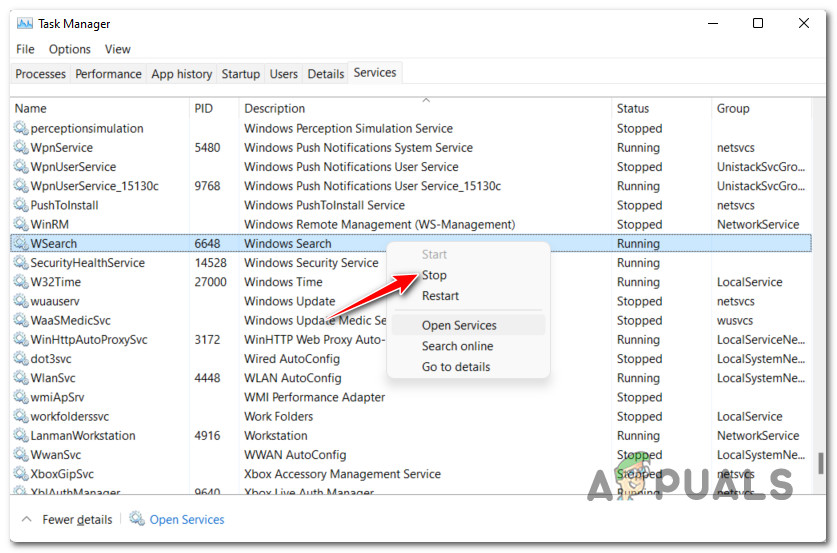
Stopping the wSearch service - Once the Windows Search service has been stopped, check the Performance tab of Task Manager and see if the disk usage has gone down considerably.
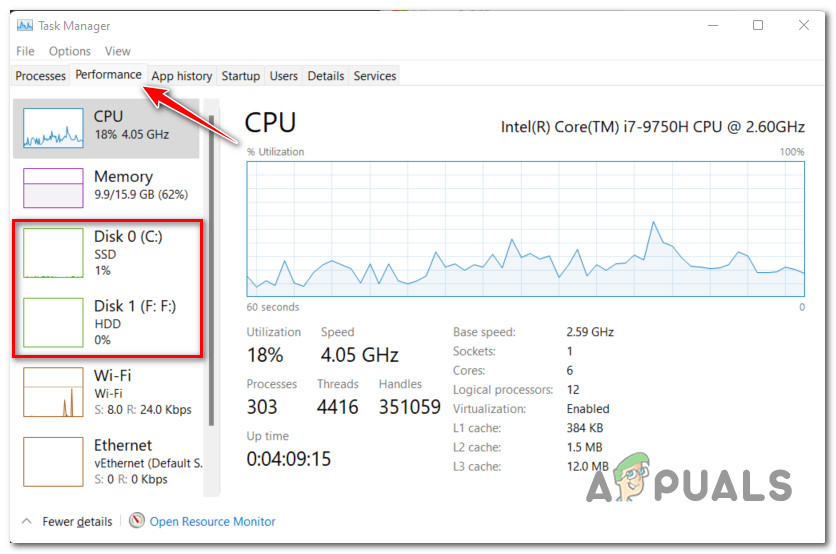
Accessing the Performance tab
If this method didn’t allow you to fix the issue as the disk usage has remained the same even after you disabled the Windows Search functionality, move down to troubleshoot against the final potential culprit below.
9. Disable Link Power Management (if applicable)
If you’re using Intel’s Rapid Storage Technology, there’s a big chance that you’re dealing with some kind of conflict caused by the Link Power Management feature.
Note: Link Power Management (LPM) is a power management feature that’s used on modern Windows iterations to provide greater latency to USB devices and optimize power usage.
Even this option is generally good for your system and you should keep it enabled in almost every scenario, it’s also known to conflict with the proprietary driver used by Intel’s Rapid Storage Technology.
To resolve this conflict, your only option is to disable the Link Power Management (LPM) component using the Power Options menu associated with the active power plan that you’re using.
Follow the instructions below for specific steps on how to do this:
- Press Windows key + R to open up a Run dialog box. Next, type ‘powercfg.cpl’ inside the text box and press Enter to open up the Power Options menu.
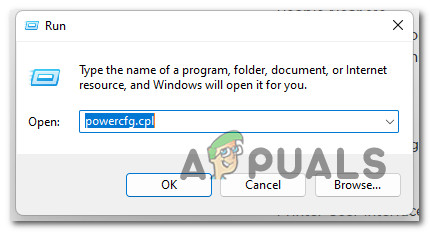
Accessing the Power Options menu - Once you’re inside the Power Options screen of the classic Control Panel menu, move over to the right-hand pane and click on Change Plan Settings after you’ve selected the active power plan.

Change Plan Settings - Next, click on Change advanced power settings from the menu under the general power settings.
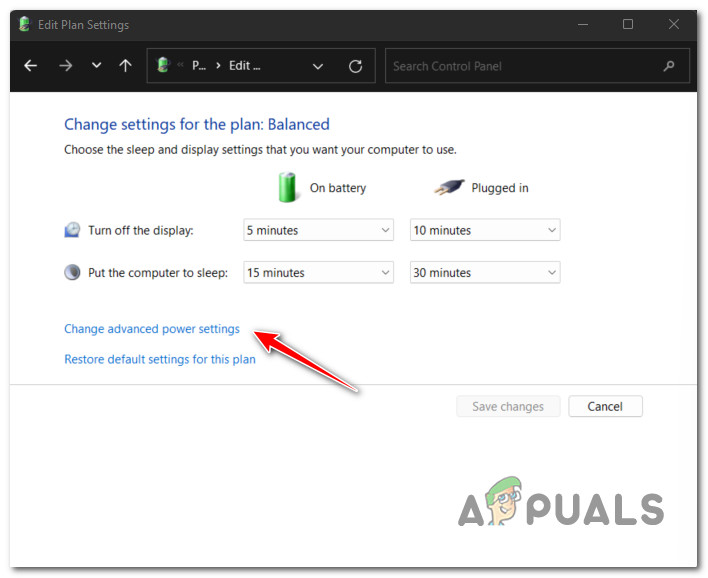
Change the advanced power settings - Once you’re inside the Power Options menu, scroll down to PCI Express and Expand the drop-down menu to find the Link State Power Management.
- Next, Expand the Link State Power Management menu too, then set both On battery and Plugged in to Off.
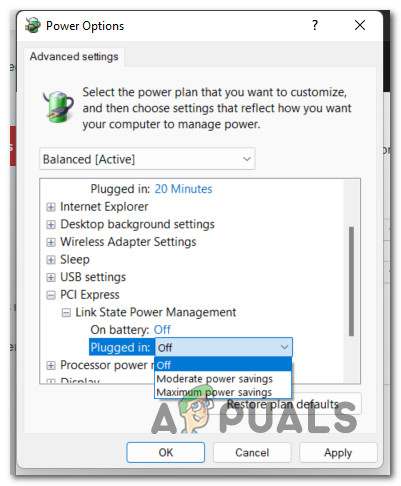
Disabling the Link State Power Management feature from the Power Options menu - Once you’ve effectively disabled the Link State Power Management feature, click on Apply to save the changes.
- Reboot your PC in order to allow these changes to take effect, then check if the disk usage issue has been resolved once Windows 11 boots back.





